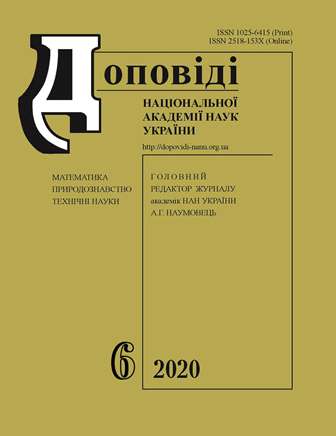Глибинні розплави магматичних каналів великих вулканів Західної Антарктиди: нові експериментальні дані
DOI:
https://doi.org/10.15407/dopovidi2020.06.046Ключові слова:
вулкани, глибинна будова, Еребус, Західна Антарктида, мобільна технологія, море Росса, обробка даних ДЗЗ, прямі пошукиАнотація
Отримано нові експериментальні дані про глибинний розподіл частотно-резонансних характеристик порід для окремих вулканів і вулканічних провінцій Західної Антарктиди і Антарктики. Результати досліджень показують існування в Західній Антарктиді складної магмо-газо-флюїдної системи, що складається з ряду магматичних камер, які живляться магмами, піднятими з мантії в проміжні (корові) зони накопичення. Для вулканічних провінцій виділені глибинні границі положення коренів каналів (вулканів) різного віку — 95, 217, 470 і 723 км. Це свідчить про істотну роль багатофазної імпульсної вулканічної діяльності (по вертикальних каналах міграції глибинних флюїдів) у формуванні тектонічної різноманітності і еволюції структур континентальних окраїн антарктичного регіону. За даними частотно-резонансних досліджень, канали з різною глибиною розплаву заповнені базальтами, кімберлітами, ультрамафітами і різними групами осадових порід. Наявність вулканічних структур з корінням на різних глибинах дозволяє припустити їх закономірний зв'язок з процесами тектонічної активізації, які відбувалися в цих регіонах за останні 500 млн років. Використання еталонних частот для різних типів відомих порід дозволяє застосовувати частотно-резонансні методи для вивчення глибинної будови нашої планети і рішення проблем пошуків багатьох видів корисних копалин.
Завантаження
Посилання
Bakhmutov, V. G., Tretyak, K. R., Maksimchuk, V. Yu. et al., іn. (2017). The structure and dynamics of geophysical fields at West Antarctica. Lviv (in Ukrainian).
Levashov, S. P., Yakimchuk, N. A. & Korchagin, I. N. (2012). Frequency-resonance principle, mobile geoelectric technology: a new paradigm of geophysical research. Geophysical journal. 34, No. 4, pp. 167-176 (in Russian).
Udintsev, G. B, Beresnev, A. F., Kurentsova, N. A. et al. (2010). Drake Strait and the Skosha Sea — ocean gate of Western Antarctica. Structure and history of the development of the lithosphere. Moscow: Paulsen (in Russian).
Yakimchuk, N. A. & Korchagin, I. N. (2019). The study of the internal structure of volcanic complexes of various types according to the results of frequency-resonance processing of satellite images and photographs. Geoinformatics, No. 4, pp. 5-18 (in Russian).
Yakimchuk, N. A., Korchagin, I. N., Bakhmutov, V. G. & Soloviev, V. D. (2019). Geophysical surveys in the Ukrainian Ukrainian Antarctic Expedition 2018: mobile measuring equipment, innovative direct search methods, new results. Geoinformatika, No. 1, pp. 5-27 (in Russian).
Daya, J. M. D., Harveyb, R. P. & Hiltona, D. R. (2019). Melt-modified lithosphere beneath Ross Island and its role in the tectono-magmatic evolution of the West Antarctic Rift System. Chemical Geology, 518, pp. 45-54. https://doi.org/10.1016/j.chemgeo.2019.04.012
Gupta, S., Zhao, D. & Rai, S. S. (2009). Seismic imaging of the upper mantle under the Erebus hotspot in Antarctica. Gondwana research, 16, pp. 109-118.
Haeger, C., Kaban, M. & Tesauro, M. (2019). 3’D Density, Thermal, and Compositional Model of the Antarctic Lithosphere and Implications for Its Evolution. Geochemistry, Geophysics. Geosystems, 20, Iss. 2, pp. 688-707. https://doi.org/10.1029/2018GC008033
Hill, G. J. (2019). On the Use of Electromagnetics for Earth Imaging of the Polar Regions. Surveys in Geophysics. https://doi.org/10.1007/s10712-019-09570-8
Iakovino, K. (2015). Linking subsurface to surface degassing at active volcanoes: Athermodynamic model with applications to Erebus volcano. ESPL, 431, pp. 59-74.
Rocchi, S., Armienti, P., D’Orazio, M. et al. (2002). Cenozoic magmatism in the western Ross Embayment: Role of mantle plume versus plate dynamics in the development of the West Antarctic Rift System. JGR, 107, No. B9, pp. 1-22. https://doi.org/10.1029/2001JB000515
Shen, W., Wiens, D. A., Anandakrishnan, S. et al. (2018). The Crust and Upper Mantle Structure of Central and West Antarctica From Bayesian Inversion of Rayleigh Wave and Receiver Functions. JGR: Solid Earth, 123, pp. 7824-7849. https://doi.org/10.1029/2017JB015346
Vries, M. V. W., Bingham, R. G. & Hein A. S. (2017). A new volcanic province: an inventory of subglacial volcanoes in West Antarctica Geological Society, London, Special Publications, 461, pp. 231-248. https://doi.org/10.1144/SP461.7
Winberry, J. P. & Anandakrishnan, S. (2004). Crustal structure of the West Antarctic rift system and Marie Byrd Land hotspot. Geology, 32(11), pp. 977-980. https://doi.org/10.1130/g20768.1
##submission.downloads##
Опубліковано
Як цитувати
Номер
Розділ
Ліцензія
Авторське право (c) 2023 Доповіді Національної академії наук України

Ця робота ліцензується відповідно до Creative Commons Attribution-NonCommercial 4.0 International License.




